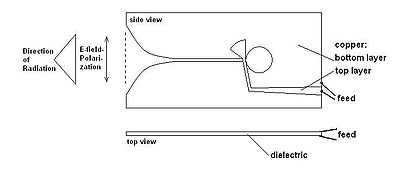A Vivaldi antenna or Vivaldi aerial[1] or tapered slot antenna[2] is a co-planar broadband-antenna, which can be made from a solid piece of sheet metal, a printed circuit board, or from a dielectric plate metalized on one or both sides.

The feedline excites an open space via a microstrip line or coaxial cable, and may be terminated with either a sector-shaped area or a direct coaxial connection. From the open space, the signal traverses an exponentially tapered pattern via a symmetrical slot line.

Vivaldi antennas can be made for linear polarized waves or – using two devices arranged in orthogonal direction – for transmitting / receiving both polarization orientations.
If fed with 90° phase-shifted signals, orthogonal devices can transmit/receive circular-oriented electromagnetic waves.
Vivaldi antennas are useful for any frequency, as all antennas are scalable in size for use at any wavelength. Printed circuit technology makes this type antenna cost effective for microwave frequencies 1 GHz or higher.

Advantages of Vivaldi antennas are their broadband characteristics (suitable for ultra-wideband signals [3]), their easy manufacturing process using common methods for PCB production, and their easy impedance matching to the feeding line using microstrip line modeling methods.
The MWEE collection of EM simulation benchmarks includes a Vivaldi antenna.[4][5][6][7][8][9]
Several researchers have experimented variations in the shape of the Vivaldi antenna to improve some of its characteristics. An example is the Palm Tree Vivaldi Antenna, with greater gain and directivity, used in Near-Field Microwave Biomedical Imaging Applications. [10][11]
- ^ Peter J. Gibson: The Vivaldi Aerial, 9th European Microwave Conference Proceedings, Brighton, 1979, p. 101–105.
- ^ Milligan, Thomas (2005). Modern antenna design (Second ed.). Hoboken, N.J.: John Wiley & Sons, Inc. p. 512. ISBN 9780471457763. OCLC 85820949.
- ^ de Oliveira, A.M.; Perotoni, M.B.; Kofuji, S.T.; Justo, J.F. (2015). "A palm tree antipodal Vivaldi antenna with exponential slot edge for improved radiation pattern". IEEE Antennas Wirel. Propag. Lett. 14: 1334. Bibcode:2015IAWPL..14.1334D. doi:10.1109/LAWP.2015.2404875. S2CID 25921138.
- ^ "Vivaldi Antenna". CST Computer Simulation Technology. 25 July 2023. Archived from the original on 2 September 2018. Retrieved 23 April 2024.
- ^ "The 2000 CAD Benchmark". Microwave Engineering Europe. Archived from the original on 2023-11-12. Retrieved 2013-05-28.
- ^ "Design An X-Band Vivaldi Antenna". Microwaves and RF. Archived from the original on 2009-01-05. Retrieved 2009-02-26.
- ^ Burrell, D.A.; Aberle, J.T. (1993). "Characterization of Vivaldi antennas utilizing a microstrip-to-slotline transition". Proceedings of IEEE Antennas and Propagation Society International Symposium. pp. 1212–1215. doi:10.1109/APS.1993.385130. ISBN 0-7803-1246-5. S2CID 122962623. Archived (PDF) from the original on 2024-04-23. Retrieved 2013-05-28.
- ^ "Dual-orthogonal polarized Vivaldi Antenna for Ultra Wideband Applications". Archived from the original on 2016-03-04. Retrieved 2013-05-28.
- ^ "Vivaldi antenna". Archived from the original on 2012-09-28. Retrieved 2009-02-26.
- ^ Figueredo, Raimundo Eider; de Oliveira, Alexandre M.; Nurhayati, Nurhayati; de O. Neto, Antonio Mendes; Nogueira, Ingrid C.; Justo, Joao F.; Perotoni, Marcelo B.; de Carvalho, Arnaldo (3 October 2020). "A Vivaldi Antenna Palm Tree Class with Koch Square Fractal Slot Edge for Near-Field Microwave Biomedical Imaging Applications". 2020 Third International Conference on Vocational Education and Electrical Engineering (ICVEE). pp. 1–6. doi:10.1109/ICVEE50212.2020.9243220. ISBN 978-1-7281-7434-1. S2CID 226265209.
- ^ de Oliveira, Alexandre Manicoba; de Oliveira Neto, Antonio Mendes; Perotoni, Marcelo Bender; Nurhayati, Nurhayati; Baudrand, Henri; de Carvalho, Arnaldo; Justo, Joao Francisco (December 2021). "A Fern Antipodal Vivaldi Antenna for Near-Field Microwave Imaging Medical Applications". IEEE Transactions on Antennas and Propagation. 69 (12): 8816–8829. Bibcode:2021ITAP...69.8816D. doi:10.1109/TAP.2021.3096942. S2CID 238937551.